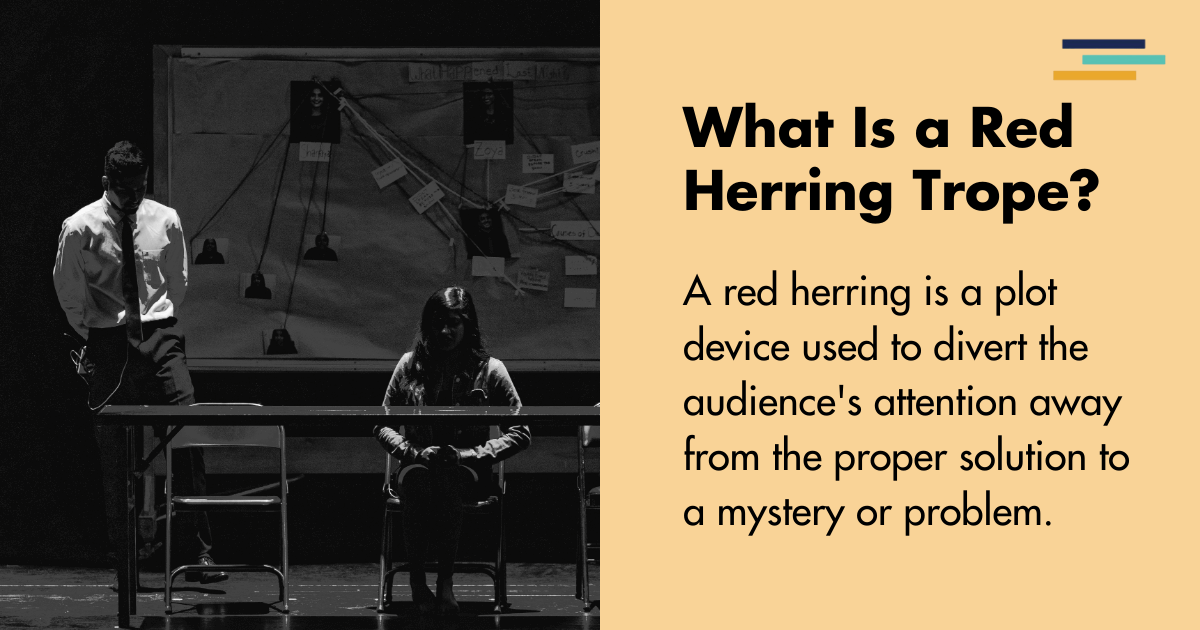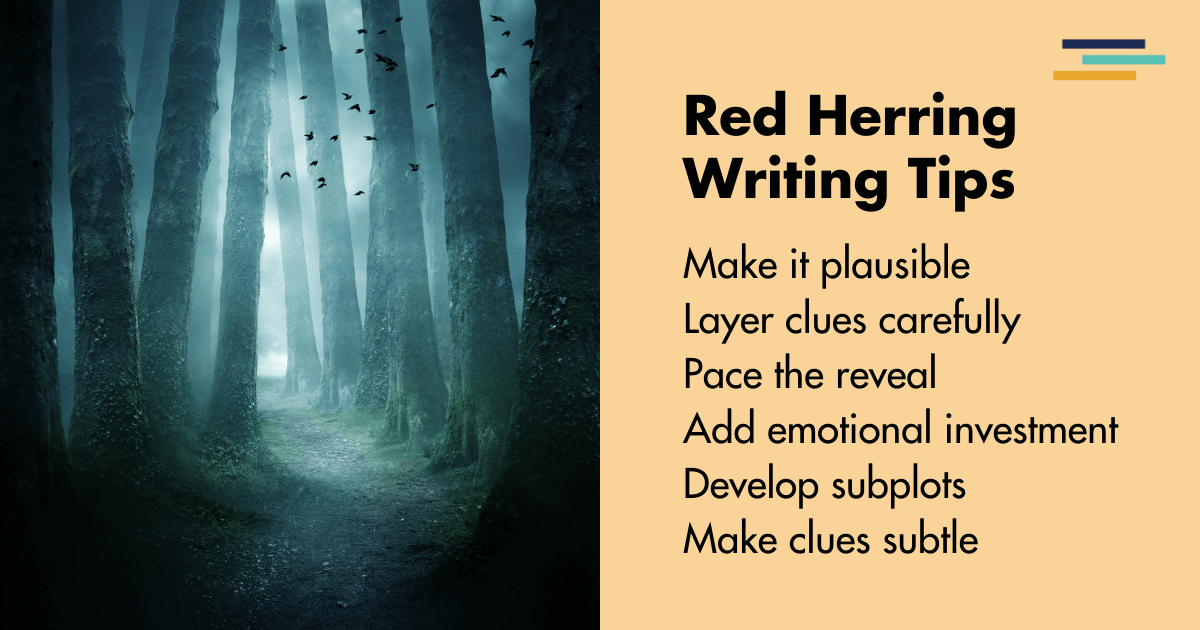
Picture this…
You’re reading a mystery novel, completely engrossed, and you’re sure you’ve figured out who the villain is.
Then, BAM. Plot twist!
That suspect you were so convinced about? Not the villain at all. You’ve just been bamboozled by one of the most classic literary devices around…
The red herring.
Red herrings are like that friend who misleads you during a scavenger hunt. Pointing you toward the garden when the prize hides in the attic. They’re meant to distract, confuse, and throw both readers and characters off the scent, only for the real solution to swoop in at the end, leaving you shaking your head at how you didn’t see it coming.
In this article, we’ll explore what red herrings are, how they show up in various media, and how you can use them to create a gripping narrative that keeps your readers guessing until the very last page.
What Is a Red Herring Trope?
A red herring is a plot device used to divert the audience’s attention away from the proper solution to a mystery or problem.
It’s essentially a misdirection, a false clue meant to trick readers or characters into thinking they’ve found the answer. When in reality, the truth is something entirely different.
The term red herring originally comes from the practice of using strong-smelling fish to distract hunting dogs from a scent trail, and the idea translates perfectly into storytelling.
In fiction, authors often use red herrings in mysteries, thrillers, and detective stories, but they can pop up in any genre.
A well-placed red herring keeps readers on their toes, questioning their assumptions and eagerly turning the page to figure out what happens next. But, like any good twist, it has to be handled with care.
Overuse or obvious misdirections can frustrate readers rather than delight them.

Red Herring Examples in Real Life
Believe it or not, red herrings aren’t just limited to the pages of your favorite whodunits.
They also pop up in real life more often than you’d think. From politics to sports, misdirection is a tactic people use all the time.
Let’s look at some everyday examples.
1. Political Misdirection
Politicians often use red herrings during debates or interviews to steer the conversation away from tough questions.
Imagine a candidate being asked about their stance on healthcare reform, but instead of answering, they talk about their love for local sports teams.
That’s a red herring.
A distraction to lead the audience away from the original issue. It’s a tried-and-true tactic that shifts the focus and often works if the audience gets caught up in the misdirection.
2. Legal Proceedings
Lawyers sometimes use red herrings in courtrooms to distract the jury.
By presenting evidence or witness testimony that seems important but ultimately has nothing to do with the case, they create doubt about the real issue.
It’s all about making the opposition work harder to prove their point while the defense throws out distractions.
3. Marketing and Advertising
Have you ever been drawn in by a flashy commercial that promised to solve all your problems, only to realize the product didn’t quite deliver?
Advertisers often use red herrings to make products seem more appealing than they are. They’ll focus on one amazing (but often irrelevant) feature to distract you from the fact that the product itself might not be what you need.
Red Herring Examples in Movies
Red herrings have been used to impressive effect in cinema for decades, especially in suspense, thriller, and mystery films.
Some of the best-known movies have misled audiences with brilliant red herrings that kept everyone guessing until the end.
Here are some standout examples.
1. Psycho (1960)
Alfred Hitchcock was the master of suspense, and Psycho was no exception. The character of Marion Crane seems like the film’s protagonist until… well, we all know what happens in that infamous shower scene.
Hitchcock misleads the audience by building Marion up as the main character, only to shift the focus entirely.
Her sudden and shocking death leaves us scrambling to figure out what’s really going on, as we’ve been completely thrown off track.
2. The Usual Suspects (1995)
In The Usual Suspects, the character Verbal Kint is a seemingly harmless, low-level criminal who we assume is just a witness providing key details about the mysterious mastermind, Keyser Söze.
The red herring here is Verbal’s unreliable narration and meek persona, which misleads both the audience and the characters into thinking he’s not significant. Spoiler alert… turns out, Verbal is Söze all along.
The film masterfully uses the red herring to hide the true villain in plain sight.
3. Gone Girl (2014)
In Gone Girl, the story appears to be a straightforward mystery about a missing wife, with all evidence pointing to her husband, Nick, as the prime suspect.
The narrative pushes the audience toward this conclusion with strategically placed clues, but it turns out that Amy, the missing wife, orchestrated her disappearance all along. This is a classic red herring setup, making Nick seem guilty until the truth gets dramatically revealed.
Red Herring Examples in Media
Red herrings aren’t just for books and movies. They show up in media all the time, especially in TV shows and news stories.
Let’s explore some classic uses of red herrings in popular media.
1. Sherlock (BBC Series)
In the modern Sherlock series, almost every case involves a red herring or two.
One notable example is in the episode “The Reichenbach Fall,” where Sherlock seems to meet his end after a showdown with Moriarty. The show leads viewers to believe Sherlock has perished, but in true red herring fashion, his death is part of a complex plan, and he returns in the next season.
Misdirection plays a key role in maintaining the suspense and keeping viewers on edge.
2. Breaking Bad
In Breaking Bad, one of the show’s most shocking red herrings comes when the audience gets led to believe that Walter White’s brother-in-law, Hank, is closing in on him.
The tension builds throughout the series as Hank investigates the mysterious meth kingpin, Heisenberg…
Without realizing it’s his brother-in-law all along.
While Hank does eventually figure it out, the show constantly distracts viewers with red herrings, making them question how close Hank actually is to the truth.
3. The Walking Dead
The Walking Dead often uses red herrings to keep viewers guessing about which characters will survive and who will meet their end.
In one iconic moment, the show builds tension around the fate of Glenn Rhee, implying that a zombie horde has killed him. Fans were devastated, only for the show to reveal later that Glenn had survived.
This red herring moment kept viewers in suspense, only to pull the rug out from under them.

Examples of Red Herring in Literature
Literature is where red herrings truly shine.
Here are some classic examples of how authors have used red herrings to mislead readers and keep them hooked.
1. The Hound of the Baskervilles by Arthur Conan Doyle
In The Hound of the Baskervilles, someone tasks Sherlock Holmes with solving the mystery of a supernatural dog terrorizing the Baskerville family.
The story provides plenty of clues pointing to the idea that the hound is a supernatural creature, but it’s all a red herring.
In reality, the dog is an ordinary animal used by a villain to scare the family. Conan Doyle masterfully leads readers down the wrong path before revealing the mundane truth.
2. Murder on the Orient Express by Agatha Christie
In Agatha Christie’s Murder on the Orient Express, the mystery revolves around who killed a passenger on a train.
Christie scatters red herrings throughout the novel, suggesting various characters could be guilty, only to reveal that (spoiler alert) all of them are involved in the murder. The book is a masterclass in misdirection, keeping readers guessing until the very end.
3. The Da Vinci Code by Dan Brown
The Da Vinci Code is full of red herrings, but one of the most effective involves the character of Bishop Aringarosa.
Throughout the novel, we’re led to believe that Aringarosa is orchestrating the central conspiracy, but it turns out he’s not the villain at all. His involvement is a misdirection, and the true antagonist is someone else entirely.
Tips for Using Red Herrings in Your Novel
If you’re ready to sprinkle some red herrings into your own novel, here are a few tips to make sure they work effectively.
1. Make the Red Herring Plausible
A red herring needs to be believable, or your readers will catch on too quickly.
The best red herrings are those that seem like the real deal, with enough evidence to support them. Drop clues that make the false trail look convincing, but don’t overdo it. You want readers to look back and think, “I should have seen that coming!” not “That was too obvious.”
2. Layer Clues Carefully
Don’t rely on just one red herring.
Layer multiple clues throughout your story.
While one red herring distracts the audience, another should guide them subtly toward the truth.
Balancing the real clues with the false ones will make the twist even more satisfying when you reveal the truth. Think of it like a well-executed card trick. The audience is so busy looking at the wrong hand…
They don’t see what’s happening right in front of them.
3. Pace the Reveal
Timing is everything with red herrings.
If you reveal too early that the clue was a distraction, it loses its impact. Build tension by letting the red herring develop, giving it enough time to seem legitimate.
But don’t string it along too far. Once your readers figure out the trick, you don’t want them feeling duped. The best red herrings make readers second-guess themselves, not regret ever trusting you.
4. Create Emotional Investment
To make your red herring hit even harder, create emotional stakes around it.
If the false clue involves a beloved character or a heart-wrenching decision, readers will be more invested and, therefore, more likely to fall for the misdirection.
Red herrings aren’t just about fooling readers. They’re about playing with their emotions, too. And what better way to toy with someone’s heart than to make them care about the misdirection?

5. Tie the Red Herring to Your Theme
A well-executed red herring doesn’t just mislead the audience. It also ties into the story’s larger theme.
For example, if your story explores trust and betrayal, your red herring could revolve around a character who seems trustworthy but isn’t.
This way, even when you reveal the red herring, it still feels like an essential part of the narrative, not just a plot gimmick. It’s a twist that feels earned because it deepens the thematic experience.
6. Use Red Herrings to Develop Subplots
A great way to incorporate red herrings is to use them to develop subplots.
Rather than throwing in random distractions, have the red herring be part of a character’s journey or a secondary conflict.
This makes the red herring feel more organic and less like you’re waving your hands wildly and shouting, “Look over here!” Plus, when it ties back to a subplot, it can still add value to the overall story, even after you reveal the misdirection.
7. Make the Real Clue Hard to Spot
A successful red herring isn’t just about the distraction. It’s also about hiding the real clue in plain sight.
The key is to bury the truth beneath all the misdirection without making it too obvious.
Slip the actual clue into a scene where you direct the reader’s focus elsewhere, so when they look back, they’ll have that wonderful, “Aha!” moment. A well-hidden clue is like a magician’s sleight of hand…
It was there the whole time, but you were too busy watching the wrong thing.
8. Don’t Overuse Red Herrings
As much fun as red herrings can be, using too many in one story can lead to reader fatigue. If every other chapter has a new misdirection, readers might stop taking the clues seriously, which weakens the impact of the last twist.
Use red herrings sparingly, and make sure they’re meaningful rather than just confusing for the sake of it.
Think of them like salt. Too much, and you ruin the whole dish.
9. Let Characters Fall for the Red Herring
Red herrings work best when both the reader and the characters fall for them.
If your protagonist becomes convinced by the false clue, readers are more likely to believe it too. After all, if the hero doesn’t see through the misdirection, how could your readers?
Having your characters emotionally or logically invest in the red herring makes it feel like a natural part of the plot, rather than a trick pulled just to fool the reader.
10. Keep the Ending Satisfying
Even after you reveal the red herring, make sure your ending remains satisfying.
Readers should feel that the actual solution was well-supported by clues along the way, not just a last-minute twist thrown in for shock value.
The best red herrings don’t undermine the ending. They enhance it by making the journey toward the truth more complex and engaging. A satisfying conclusion should leave readers feeling clever for figuring it out…
Or at least eager to read the story again, looking for all the clues they missed.
And finally, always remember that the story comes first. Focus on:
- Creating engaging characters
- Penning interesting plots
- Structuring solid settings
A tool like Fictionary helps you turn your draft into an interesting story readers love. So, with a strong narrative foundation, your writing can truly shine.


